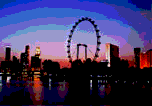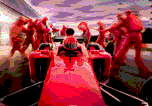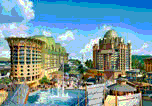题目内容
阅读理解。
F1 is a very fast car race. It is one of the most popular sports in the world. The drivers go at over
300 kilometers an hour every race. But F1 cars didn't always go so fast.
In 1895, the first F1 race began in France. During that race, it took the drivers 48 hours to finish
580 kilometers. In 1901, the best drivers had an average (平均) speed of 100 kilometers an hour.
Modern grand prix (奖品) F1 racing began in 1950 in Britain. Grand prix is French. It means "large
prize". Today, 12 teams and 24 drivers race to get points. There are races at different tracks (路线) all
over the world from March to October every year. There are also F2 and F3 racing. But the cars are
slower and less high-tech.
During a F1 race, drivers have to make several stops to change tyres(轮胎) and put more petrol in
their cars. A team of people do these tasks together to make the stops short. Some people lift the car
up, others change the tyres. While this team works on the tyres, another person puts petrol in the car
and a different person cleans the driver's helmet. One more person talks to the driver about how to win.
It's amazing that all those people finish it in just a few seconds!
During 100-meter races, people count the athletes' speed by 1/100th (0. 01) of a second, for example
10.81 seconds. In the world of car racing, however, the race has to be timed to 1/1,000th(0. 001) of a
second. That is 50 times faster than the time for a blink (眨眼).
F1 cars look very colorful. First, cars of different teams have different colors. Then there are a lot
of advertisements on the cars.
300 kilometers an hour every race. But F1 cars didn't always go so fast.
In 1895, the first F1 race began in France. During that race, it took the drivers 48 hours to finish
580 kilometers. In 1901, the best drivers had an average (平均) speed of 100 kilometers an hour.
Modern grand prix (奖品) F1 racing began in 1950 in Britain. Grand prix is French. It means "large
prize". Today, 12 teams and 24 drivers race to get points. There are races at different tracks (路线) all
over the world from March to October every year. There are also F2 and F3 racing. But the cars are
slower and less high-tech.
During a F1 race, drivers have to make several stops to change tyres(轮胎) and put more petrol in
their cars. A team of people do these tasks together to make the stops short. Some people lift the car
up, others change the tyres. While this team works on the tyres, another person puts petrol in the car
and a different person cleans the driver's helmet. One more person talks to the driver about how to win.
It's amazing that all those people finish it in just a few seconds!
During 100-meter races, people count the athletes' speed by 1/100th (0. 01) of a second, for example
10.81 seconds. In the world of car racing, however, the race has to be timed to 1/1,000th(0. 001) of a
second. That is 50 times faster than the time for a blink (眨眼).
F1 cars look very colorful. First, cars of different teams have different colors. Then there are a lot
of advertisements on the cars.
1. The best drivers in F1 races can reach the speed of ____ an hour.
A. 100 kilometers
B. 300 kilometers
C. 580 kilometers
D. 1,000 kilometers
B. 300 kilometers
C. 580 kilometers
D. 1,000 kilometers
2. Modern grand prix F1 racing first began ____.
A. in France
B. in Britain
C. in 1895
D. in 1901
B. in Britain
C. in 1895
D. in 1901
3. Today F1 race is held ____.
A. at different tracks all the year round
B. every month all over the world
C. from March to October every year
D. in France and Britain every year
B. every month all over the world
C. from March to October every year
D. in France and Britain every year
4. When the driver makes stops in a race, a team of people will ____.
A. help him make the stops short
B. lift the car up and change the tyres
C. put petrol in the car and clean the car
D. clean the driver's helmet
B. lift the car up and change the tyres
C. put petrol in the car and clean the car
D. clean the driver's helmet
5. In the world of car racing, the race has to be timed to ____.
A. second
B. 10. 81 second
C. 1/100th of a second
D. 1/1,000th of a second
B. 10. 81 second
C. 1/100th of a second
D. 1/1,000th of a second
1-5 BBCAD

练习册系列答案
相关题目
| |||||||||||||||||||||||||||||||||||||||||||||||||||||||||||||||||||||||||
| 阅读理解。 | ||||||||||||
| ||||||||||||
| 1. Which is NOT true about the Singapore Flyer? | ||||||||||||
|
[ ] | ||||||||||||
| A. It is the highest ferris wheel in the world. B. It is about 42 meters high. C. It was opened in 2008. D. You can see the beautiful city from it. | ||||||||||||
| 2. F1 race is special because it'll be held _________. | ||||||||||||
|
[ ] | ||||||||||||
| A. in the night B. in Singapore C. in September D. through the city's hottest places | ||||||||||||
| 3. The Marina Bay Sands may open in the year of ________. | ||||||||||||
|
[ ] | ||||||||||||
| A. 2007 B. 2008 C. 2009 D. 2010 | ||||||||||||
| 4. We know ________ kinds of interesting places in Resorts World from the passage. | ||||||||||||
|
[ ] | ||||||||||||
| A. two B. three C. four D. five | ||||||||||||
| 5. Which is the right order according to the time they open? a. The Marina Bay Sands b. Resorts World c. Top Car Race d. The Singapore Flyer | ||||||||||||
|
[ ] | ||||||||||||
| A. d-c-a-b B. d-a-b-c C. a-b-d-c D. d-a-b-c |




